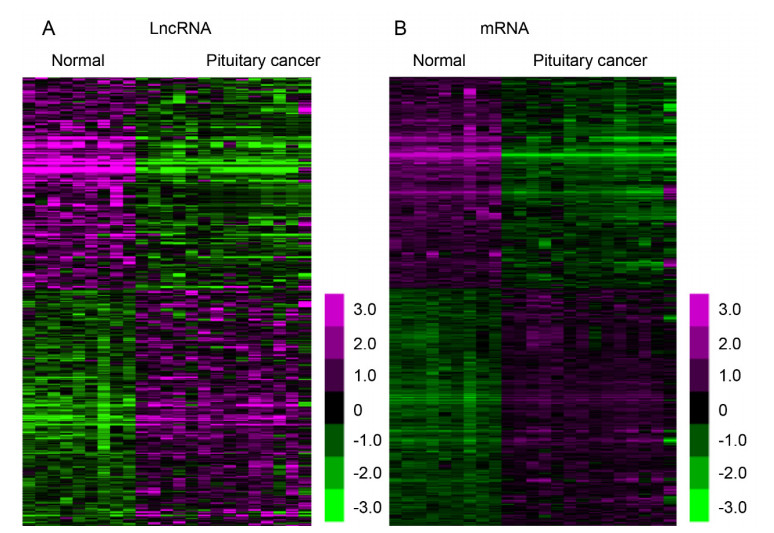1.
Introduction
Long noncoding RNAs (lncRNAs) were a type of ncRNAs longer than 200 bps, which could not be translated to proteins [1,2]. LncRNAs comprised antisense RNA, intronic transcripts, promoter-related lncRNA, long intergenic ncRNAs (lincRNA), and UTR associated lncRNAs [3]. Previous studies indicated lncRNAs played crucial roles in cancer progression and were involved in regulating cancer cell proliferation, apoptosis, autophagy and metastasis [4,5]. LncRNAs could regulate targets transcription via recruiting epigenetic modification regulators [6] and transcription factors [7]. LncRNAs could also regulate targets post-transcriptional expression via sponging miRNAs [8]. For instance, lncRNA PTENP1 could increase PTEN levels via sponging PTEN-targeting miRNAs [9,10]. PCGEM1 and PRNCR1 interacted with androgen receptor to promote transcriptional activity [11].
Pituitary adenomas (PA) is one of the most frequent types of intracranial neoplasms [12]. Surgery remains the first line of treatment for the majority of patients, but it cannot effectively control invasive pituitary adenomas [13]. In the past decades, emerging efforts were paid to understand the mechanisms underlying PA. Fukuoka et al. identifed EGFR as a therapeutic target for ACTH-secreting PA [14]. ADAM12 and MMP-14 were reported to regulate PA cavernous sinus invasion [15]. Meanwhile, non-coding RNAs (ncRNAs) were also found to play crucial roles in PA progression. For instance, miR-23b and miR-130b was reduced in PA [16]. miR-26a regulated cell cycle in ACTH-secreting PA by suppressing PRKCD [17]. Very interestingly, recent studies showed lncRNAs were dysregulated and played either oncogenetic or tumor suppressive roles in pituitary adenomas. For example, IFNG-AS1 interacted with ESRP2 to promote PA progression [18]. SNHG1 could sponge miR-302/372/373/520 cluster to active Wnt signaling in PA [19]. LncRNA MEG3 served as a tumor suppressor in PA [20]. Exploring the roles of lncRNAs in PA might shed light on the biology behind this disease and could prove novel potential biomarkers for PA prognosis.
In this study, we performed analysis of GSE26966 dataset to identify differently expressed lncRNAs in PA. In order to reveal the mechanism and function roles of them, we constructed lncRNA co-expression, lncRNA-protein interaction, and ceRNA networks in PA. We thought this study could provide novel clues to verify lncRNAs could be potential targets in PA diagnosis and therapy.
2.
Materials and methods
2.1. Public datasets analysis
GSE26966 [21] dataset was used to identify dysregulated lncRNAs in PA, which was downloaded from GEO database (http://www.ncbi.nlm.nih.gov/geo/). GSE26966 included nine normal samples and 14 PA tissues. This dataset was normalized using robust multi-array average (RMA) method under R 2.6.2 statistical software with affy package from BioConductor. LncRNAs and mRNAs with fold changes (FC) ≥ 2 and P values less than 0.05 were considered as differentially expressed genes (DEGs).
2.2. Construction of PPI network
Protein-protein interaction network (PPI) was constructed by STRING online software (https://string-db.org/). Combined score > 0.4 was considered as reliable. The PPI network was visualized using software Cytoscape software (http://www.cytoscape.org).
2.3. Functional and pathway enrichment analyses
Functional and pathway enrichment analyses were conducted using the DAVID software (https://david.ncifcrf.gov/tools.jsp). The p value < 0.05 was set as the threshold.
2.4. Pituitary tumour samples
Human pituitary tumour tissue samples were obtained from patients who underwent surgery at Department of Neurosurgery of Shanghai University of Traditional Chinese Medicine (Shanghai, China) between 2015 and 2017. Non-neoplastic pituitary gland specimens were obtained from autopsy. Tissues were frozen and stored in liquid nitrogen. All cases were pathologically diagnosed. All of the patients were provided written informed consent. The use of human specimens in this study was permitted by the local ethics committee at Shanghai University of Traditional Chinese Medicine.
2.5. RNA extraction and RT-qPCR
Total RNA was extracted from the cells using TRIzol reagent (Invitrogen). cDNA was synthesized using the Takara PrimeScriptTM RT reagent kit. QPCR analysis using SYBR Green Supermix reagent (Invitrogen). The PCR primers used in this study included, ACTB-F 5'-CCTCTCCCAAGTCCACACAG-3' and -R 5'-GGGCACGAAGGCTCATCATT-3'; SNHG5-F 5'-CGCTTGGTTAAAACCTGACACT-3' and -R 5'-CCAAGACAATCTGGCCTCTATC-3'; SNHG7-F 5'-GTTGGGGTGTTGGCATTCTTGTT-3' and -R 5'-TGGTCAGCCTGGTCACTCTGG-3'; KCNQ1OT1-F 5'-AGGGTGACAGTGTTTCATAGGCT-3' and -R 5'-GAGGCACATTCATTCGTTGGT-3'; MEG3-F 5'-CTGCCCATCTACACCTCACG-3' and -R 5'-CTCTCCGCCGTCTGCGCTAGGGGCT-3'; Relative gene expression was analyzed using the 2-ΔΔCt method.
2.6. Statistical analysis
Statistical comparisons between groups were performed using T-test or Mann-Whitney U-test according to the test condition. A p < 0.05 was considered statistical significance with a 95% confidence level.
3.
Results
3.1. Identification of differentially expressed lncRNAs and mRNA in PA
In this study, we identify differentially expressed mRNAs and lncRNAs in PA using GSE26966 dataset, which included 9 normal and 14 PA samples. We found 115 lncRNAs were overexpressed and 98 lncRNAs expression were suppressed in PA compared to normal samples (Figure 1A). Meanwhile, a total of 1258 mRNAs were overexpressed and 2584 mRNAs expression were reduced in PA (Figure 1B). Hierarchical clustering analysis was performed to show differentially expressed genes in PA.
3.2. Construction of lncRNAs mediated co-expression network in PA
Meanwhile, we constructed lncRNA co-expression networks to reveal the potential functions and mechanisms of differently expressed lncRNAs in PA. We next calculated Spearman Rank Correlation of lncRNA-mRNA pairs using online Co-LncRNA system (http://bio-bigdata.hrbmu.edu.cn/Co-LncRNA/) and selected lncRNA-mRNA pairs with absolute value ≥ 0.9 for co-expression network construction. This network included 118 lncRNAs and 542 mRNAs (Figure 2).
A few lncRNAs were observed to play more important roles in PA tumorigenesis, such as MEG3, SNHG7, MIR612, PWAR6, RP11-119F7.5, KCNQ1OT1, CELP, LINC00511, and LOC100129175. These lncRNAs co-expressed with more than 20 mRNAs. Among them, the roles of MEG3 had been widely reported, which played as a tumor suppressor in PA.
3.3. Bioinformatics analysis of differentially expressed lncRNAs in PA
The mechanisms underlying PA remained largely unclear. In the present study, we considered co-expressing mRNAs with absolute value ≥ 0.9 were the potential targets of differentially expressed lncRNAs in PA. Then, we performed bioinformatics analysis for dysregulated lncRNAs using their co-expressing mRNAs. Our analysis showed these lncRNAs were significantly related to regulating mechanical stimulus, gene expression, in utero embryonic development, transcription, long-term synaptic potentiation, JAK-STAT cascade, cell cycle arrest, negative regulation of transcription, aging, and response to X-ray (Figure 3A). KEGG pathway analysis showed lncRNAs were involved in FoxO pathway, HIF-1 pathway, Insulin pathway, Oxytocin pathway, Adipocytokine pathway, Rap1 pathway, TGF-beta pathway, Hippo pathway, Prolactin pathway, and MAPK pathway (Figure 3B).
3.4. Construction of lncRNAs-RBPs interaction network in PA
In order to reveal the mechanisms of lncRNAs underlying PA tumorigenesis, we further constructed lncRNAs-RBPs interaction network and ceRNA network in PA. Starbase dataset was used to identify lncRNAs interacting proteins, which based on Clip-sequence analysis. As present in Figure 4, the lncRNAs-RBPs interaction network included 33 RBPs and 53 lncRNAs. Three lncRNAs (SNHG5, RP6-24A23.7 and SNHG7) interacted with more than 20 RBPs and three RBPs (FUS, eIF4AIII, and UPF) interacted with more than 20 lncRNA, which were regarded as key regulators in this network.
3.5. Construction of lncRNAs mediated ceRNA network in PA
LncRNAs mediated Competing endogenous RNA (ceRNAs) networks were constructed based on miRNA-targets prediction. The positively co-expressing lncRNA-mRNA pairs were considered for ceRNA construction. Next, the miRNAs targeted by both lncRNA and mRNA were identified as the bridge mediated the regulation between lncRNA and mRNA using TargetScan and Starbase dataset. A total of 25 lncRNAs, 58 miRNAs and 67 mRNAs were included in this ceRNA. KCNQ1OT1, SNHG7, LINC00472, and C9orf72 sponges more than 20 miRNAs and played crucial roles in PA (Figure 5).
3.6. Validation of differentially expressed lncRNAs in PA using RT-PCR
We further validate our findings by detecting the expression levels of several key lncRNAs of regulatory networks in the PA samples using RT-PCR, including KCNQ1OT1, SNHG7, SNHG5, and MEG3 expression in PA. Microarray analysis showed these lncRNAs were remarkably down-regulated in PA. RT-PCR validation showed that the expressions of KCNQ1OT1, SNHG7, SNHG5, and MEG3 were down-regulated in PA samples (Figure 6A–E). Our results were consistent with the analysis of microarray.
4.
Discussion
Pituitary adenomas (PA) is one of the most frequent types of intracranial neoplasms [12]. However, the mechanisms underlying PA progression and novel biomarkers for the prognosis of PA remained largely unclear. Recently, lncRNAs were reported to play crucial roles in the tumorigenesis, cancer proliferation, and metastasis. In PA, a few lncRNAs were revealed to be involved in the cancer progression. For instance, H19 inhibits PA cell proliferation by disrupting 4E-BP1/Raptor interaction [22], IFNG-AS1 played oncogenic roles in PA by binding to ESRP2 [18], and E2F1 regulating CCAT2 was reported as an oncogene in PA via interacting with PTTG1 [23]. Of note, a recent study performed comprehensive analysis for dysregulated lncRNAs and mRNAs in PA using RNA-sequence [24]. However, the expression pattern and potential functions of lncRNAs in PA remained to be further investigated.
This study identified differentially expressed mRNAs and lncRNAs in PA by reannotating and analyzing GSE26966 dataset. A total of 1258 overexpressed and 2584 down-regulated mRNAs, 115 overexpressed and 98 down-regulated lncRNAs were identified in PA. We observed a few lncRNAs served as key lncRNAs in PA, including such as MEG3, SNHG7, MIR612, PWAR6, RP11-119F7.5, KCNQ1OT1, CELP, LINC00511, and LOC100129175. Among these lncRNAs, MEG3 was highly expressed in normal samples but decreased in cancer samples [25]. MEG3 played important roles in cancer initiation, growth, chemo-resistance, and metastasis. In PA, MEG3 levels were decreased in tumor tissues compared to normal samples [26]. In vivo and in vitro experiments showed MEG3 remarkably inhibited tumor growth by inducing G1 phase arrest [20]. SNHG7 was observed to be overexpressed and served as an oncogene in multiple cancers, including lung cancer [27], gastric cancer [28], and bladder cancer [29]. GO and KEGG analysis showed these lncRNAs were involved in regulating mechanical stimulus, gene expression, JAK-STAT cascade, cell cycle arrest, FoxO pathway, HIF-1 pathway, Insulin pathway, Oxytocin pathway, and MAPK pathway.
LncRNAs were involved in the regulation of chromatin interactions, gene transcription, mRNA stability and translation by interacting with other types of RNA, proteins and DNAs [30]. For example, XIST regulated X chromosome inactivation by localizing to the X chromosome to recruit multiple proteins, including HDAC3 [31]. LncRNA p21 was induced by p53 and regulate gene expression by binding to hnRNP-K under DNA damage. Competing endogenous RNA (ceRNAs) played a crucial role in the regulation of tumor-related pathways. LncRNA GAS5 regulate PTEN expression by sponging miR-222-3p in thyroid cancer [32]. SNHG16 induced esophagus cancer growth and metastasis by acting as a ceRNA to sponge miR-140-5p [33]. LncRNA ZFAS1 promoted osteosarcoma progression and metastasis by sponging miR-486. In present study, we constructed lncRNAs-RBPs interaction network and ceRNA network in PA. The lncRNAs-RBPs interaction network included 33 RBPs and 53 lncRNAs. From which, we identified SNHG5, RP6-24A23.7 and SNHG7 as core lncRNAs by potentially interacting with more than 20 RBPs. Meanwhile. We found FUS, eIF4AIII, and UPF may play key roles in mediating the effects of dysregulated lncRNAs on PA progression. Meanwhile, we found KCNQ1OT1, SNHG7, LINC00472, and C9orf72 played key roles in PA which sponged about 20 miRNAs. Recent studies showed KCNQ1OT1 was dysregulated in multiple cancers. In lung cancer, KCNQ1OT1 modulated miRNA-27b-3p/HSP90AA1 axis to promote tumor progression [34]. In breast cancer, KCNQ1OT1 was overexpressed in tumor samples and induced cancer proliferation by regulating miR-145/CCNE2 axis [35]. However, the roles of KCNQ1OT1 in PA remained unclear. Our study for the first time revealed KCNQ1OT1 may play key roles in PA. Finally, we validate KCNQ1OT1, SNHG7, MEG3, and SNHG5expression in PA.
5.
Conclusions
In conclusion, this study identified differently expressed mRNAs and lncRNAs by using GSE26966 database. Furthermore, we constructed lncRNA-mRNA co-expression, lncRNA-RBP interaction and ceRNA networks. Bioinformatics analysis showed these lncRNAs were involved in regulating mechanical stimulus, gene expression, JAK-STAT cascade, cell cycle arrest, FoxO signaling, HIF-1 signaling, Insulin signaling, Oxytocin signaling, and MAPK signaling. We also showed KCNQ1OT1, SNHG7, MEG3, and SNHG5 were down-regulated in PA. Our findings could provide a novel insight to understand the mechanisms of lncRNAs underlying PA pathogenesis and identify new biomarkers for PA.
Conflict of Interest
The authors declare that they have no conflict of interest.










 DownLoad:
DownLoad:










